#Representaion
Explore tagged Tumblr posts
Text
I may be ten years late to this take but Schmidt is sincerely the best Jewish representation anywhere in the media
#He’s observant of the smaller holidays and acknowledges that there are more than two flavors of Judaism#It’s a part of his character but not the whole of it#He jokes about Judaism but will not stand for antisemitism#You cannot separate Schmidt from his Jewish identity without entirely stripping him of his character#But you cannot boil him down to only a Jew because he is very much three dimensional#The second best Jewish representation is Rebecca Bunch#And the third is Kyle Broflovski#Which is kinda sad but also impressive#New Girl#Schmidt#Winston Schmidt#Max Greenfield#Jewish#Judaism#Jumblr#South Park#Crazy Ex-Girlfriend#Representaion#Mine
51 notes
·
View notes
Text
hey remember that time social justice activists boycotted a film company into erasing jewish representation from their movie
#a sentence that is technically correct that should never have been technically correct#the one time a comic book's character's jewishness isn't erased and it gets taken away from us by the people who are pro-representation#also saying this as an israeli myself it's fucked up that it took the character being israeli to get that in the first place#i do really want israeli representaion israeli characters are practically nonexistent#but seeing how israelis are of course inhuman monsters who eat babies i don't see that happening for the foreseeable future now#leftist antisemitism#antisemitism#jumblr#hila has spoken
245 notes
·
View notes
Text
I think it’s fine to have headcanons for your favorite ships but if the dev themselves made a statement about their own characters sexuality/orientation then you shouldn’t make jokes about disrespecting that canon.
As someone who is an Unlabeled person, I’m really grateful that Teruko Tawaki is also unlabeled and sports that flag. It’s representation that I’m grateful for because unlabeled characters aren’t very well known in media at all.
My point is. Please don’t bash canon representation because you don’t agree with it. They aren’t your characters.
It’s fine to have your own headcanons, takes, what have you but at the end of the day. Canon is canon.
I get annoyed too when people conveniently erase the fact that David is Bi but not open with his feelings about that fact. That is incredible representation because growing up it is how I felt about my relationship with labels since I didn’t understand my feelings.
DRDT is aimed at an older crowd that’s on the cusp of when LGBTQIA+ wasn’t widely accepted or even legal like it is now.
So representations like Nico being closet NB, David being a repressed and conflicted bisexual man as well as Teruko choosing to be explicitly unlabeled is incredibly important representation that shouldn’t be ignored or overwritten just because you don’t agree with the creators narrative.
My point isn’t to pick a fight with anyone, mind you. I am genuinely just asking you to consider why Dev has written their characters in the way that they have and that it should be respected.
#drdt#david chiem#danganronpa despair time#danganronpa: despair time#despair time#teruko tawaki#nico hakobyan#this is NOT a discourse post. just me sharing my thoughts and experiences with life and character writing#anyway do NOT turn this into a discourse post#that isn’t the intent here#character discussion#character analysis#character representaion
241 notes
·
View notes
Text
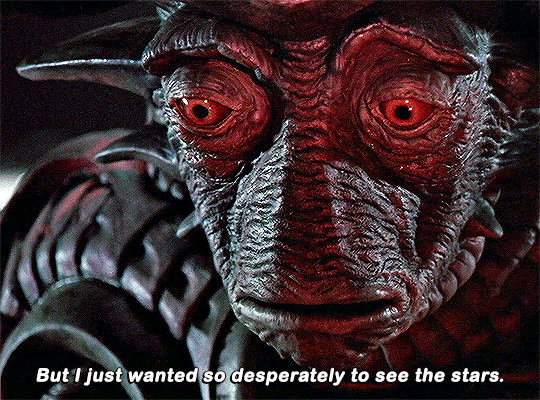

"The fate of Moya's true Pilot was sealed at that moment. So you see, Aeryn - it wasn't really you who caused her death. It was - me. If I hadn't agreed to come, Velorek may never have found a replacement Pilot."
FARSCAPE
2.05 The Way We Weren't
#farscape#farscapeedit#cinematv#filmtvcentral#userthing#smallscreensource#syfysource#kwistowee#aeryn is a visual representaion of me watching this scene#pilot my sweet boy#😭😭😭
848 notes
·
View notes
Text
One of my favorite complaints that *those* white readers, movie, and tv watchers have is that there is too much represnetation in media now. That they don’t see themselves in media anymore, and therefore cannot relate.
(Which is such a load bc white ppl have literally created a system where it’s just them, them, them. You can find a full white casted movie, tv show, and book much easier than you can with marginalized group rep. At least rep that is truthful to our lives and not romanticized and dramatized to spare white feelings.)
And this complaint is so funny to me as if I, a black girl in america, didn’t grow up watching and reading white stories over and over again. Stories I didn’t relate to or see myself in.
Now that’s not to say there wasn’t any representation. Of course there were the token poc characters that got three lines if they were lucky. And those token poc characters were written only to help the main white characters realize that the world isn’t as it seems. And “yes Jennifer, my skin color does in fact affect the way people perceive and treat me. Even you!”
The point isn’t about relatability. It is about the lesson. That’s what stories are. But with actually casting, hiring writers, directors, and producers who are from marginalized groups the lessons become life and it makes it real.
#relatability#black reader#black girl reader#poc representation#poc representaion in mainstream media#poc main characters#telling the truth#lesson v. life
95 notes
·
View notes
Text
Kpop: demon hunters (sequel ideas)
• Next movie is about them getting in sports. They are already athletic. What's stopping them.
Inspo: water diving animes.
+propagating healthy lifestyle as celebrities.
+defeating world hunger like BTS is also a charitable group. I've read it frome somewhere.
• Defeating fraud. Smth about financial education (like episodes from Smeshariki. Another male dominated set of characters *sigh*😑.)
• Next one could be about them being in a game like Spy kids 3D. There were all males so it'll be good this time the mains would be females. Make the people know about game and media addiction. And huntrix is a low-key inspiration of Totally Spies (another reason to dive into Spy kids movie).
• Them getting into bioscience and technology. Have Harry Potter elements. Like Hermionies, Lavenders and Lunas.
□ This can really turn into cinematic universe movies like how Barbie cartoon movies did. And making massive impacts, respecting the audiences' intellect and their appreciation in lore.
• Medical awareness. How looking at woman's coochie is invasive and uncomfortable in a revealing position. And stories about building families. Going into group yoga, learning about women and their stories etc.
More edits:
• Space Adventures (girls empowering space)
• Detectives 🕵️♀️ ♥️
(Marathon media had those two about spaces and detective, and spies, plus car shows. ▪︎You should consider cars too, it has popularity often with young boys so, that's what I've seen. But Kpop is a daring and innovative group so they can take challenge. They can build some stuff too like hangers and stuff. They could be like, or a character could be like Transformer's movie's Meghan Fox character, knowing, a mechanic but not pandered iykwim)
• Swan/dreamy/Fairy Tale/Romance/Princess/Tchaykovski/Classic/Balley and colorful water fountains
• Chess queen 👸 representation. A sports where the [we]men can excel and build confidence and share that trait/skill too.
• Vacation episodes. Going into Havaii. New culture and stuff. And generally relaxing, playing table tennis.
• Time travel. Medieval time. And humanity's progressions, descoveries and struggles.
So so many arcs ideas.
• 00s mystery classics (for me): ▪︎ Dark Oracle (series), ▪︎Heroes (all have special specific superpowers), ▪︎Van Helsing (it should have been a trilogy, but got a single movie, you could watch on YouTube what else was planned and ask chatGPT. It could possibly had an anime inspo like Lion king ("Kimba" white lion), so if it is correct, you could check there too. + Some people appreciate exquisite middle ages castle too. Also pleasing in aesthetics.
#huntrix#demon hunter#Sequel suggestions#Kpop#kpop demon hunters#More female oriented and female centered movies#More to us#Fems lore#Edit: And you can include specially able people#Wheelchair people#Dwarfism#invisible disability#And other#Poc#Maybe they have international interethnical songs and gatherings#In a quite exquisite and elegant places#Maybe like the great Gatsby#Or about... Leonardo Dicabrio#Ehhh#Why did I just connected him with greatest showman.#There are plenty differently able people there too#But the inspo that the real circus maker was#was creepy to those people. Idk#Edit 2: I can add more: • diabetes patches(noticed from turning red; asian-american teen girl movie representaion);#• Amon (from LOK; smb who's against power using);#might be a misognist say not agreeing women handling weapons and looking out for themselves#or#or not agreeing for artist to handle weapons because their hand should stay soft and elastic and ultimately unharmed (like in a Bratz movie#• jungle (like Spy kids 2);#animal integration (speaking; healthcare)
2 notes
·
View notes
Text


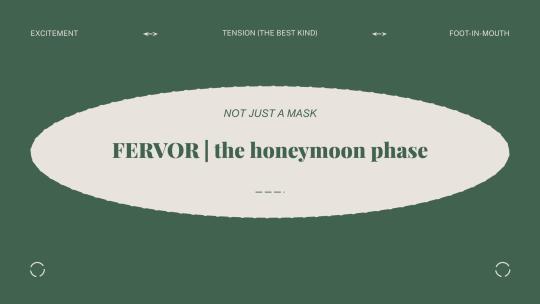
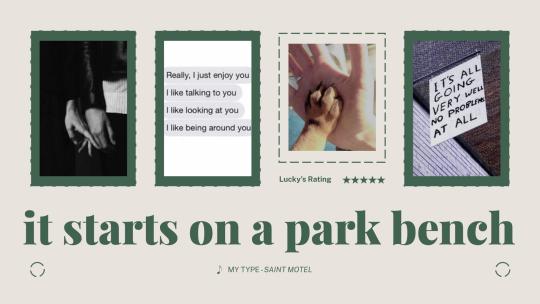
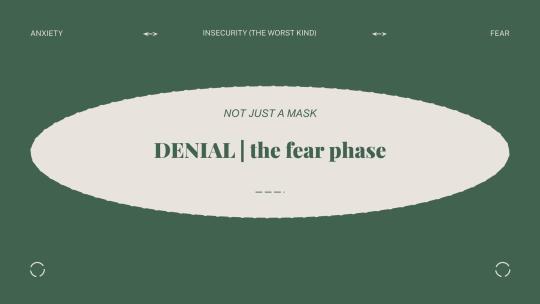
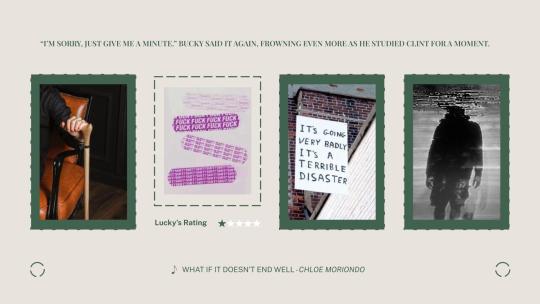
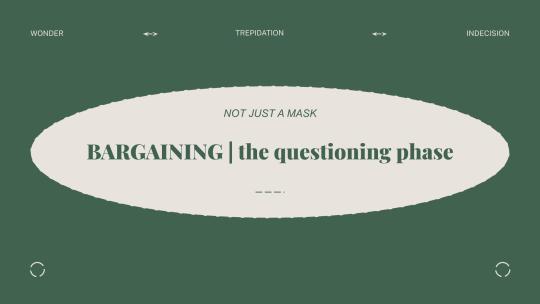
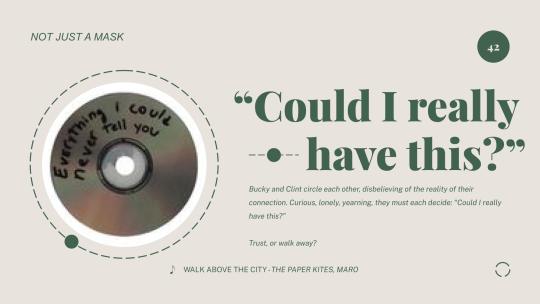

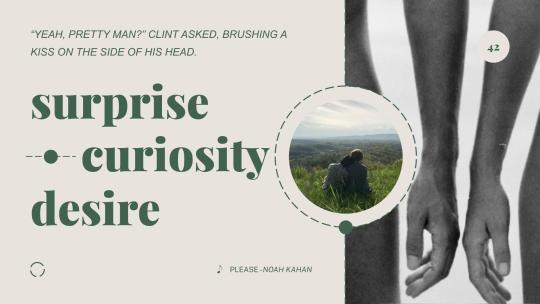
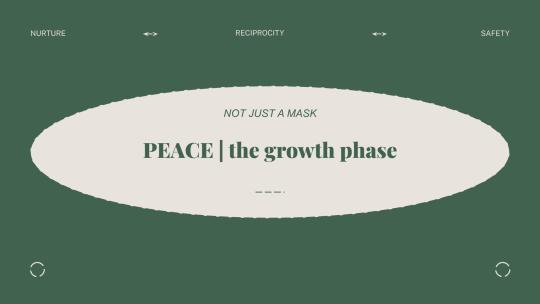
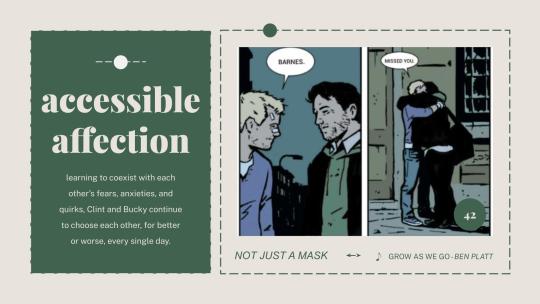
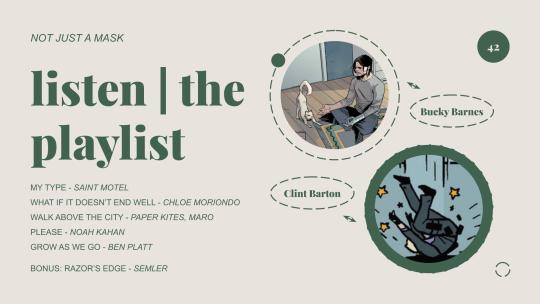


This is a lookbook / illustrated guide to @42donotpanic's amazing fic titled "Not Just a Mask" in which Clint and Bucky, two disabled queer men, meet during / following the pandemic through online dating and explore themes of intimacy, vulnerability, and accommodation as they grow closer.
The fic was created as part of the 2024 @winterhawkbigbang as was this lookbook. I had so much fun working with Panic and my fellow artists, whose works are linked on the ao3 page for the fic (AND ARE INCREDIBLE OH MY GODDD)! This lookbook was created using Canva and uses image descriptions. The playlist mentioned on slide #13 can be found on Spotify below!
#my boards#powerpoint#fanfiction#winterhawk#42donotpanic#lookbook#described#Spotify#Clint Barton#Bucky Barnes#Clint Barton/Bucky Barnes#pandemic fic#disability representaion#fic rec#marvel#marvel fanart#fan event#marvel event#exchange
7 notes
·
View notes
Text
ROMANTIC LOVE.
A STRANGE THING, TO ME. THOUGH IT CAN BE.
A
USEFUL
TOOL.
3 notes
·
View notes
Text
Test de Bechdel: ¿Por qué las pelis más taquilleras fallan miserablemente? 🎬💔
Ilustración de una mujer elegante con un gato en un desayuno sofisticado, simbolizando la representación femenina en el cine. ¿Alguna vez te has preguntado por qué en tantas películas las mujeres solo aparecen para hablar de sus crushes o para ser rescatadas? 🤔 Pues resulta que hay una herramienta súper simple que expone esta realidad: el Test de Bechdel. Y spoiler alert: muchas de tus pelis…
0 notes
Text
I don't get how can people still enjoy genshin it got so ruined I don't think it's ever recovering from that, basically every new character is either a "half naked hot mommy" or a little girl, everyone has childish faces even the men so they look the same just with different hair colors 😭 "I'm so excited for the next PALE teen looking- character with oversexualized clothing" like it's so obvious the creators gave up there are almost no new male characters and they all look buns, not a single one of them has a drop of color in their skin just blank white paper . They stopped looking good after fontaine except for the tiger(?) girl she's so fine
I get why people still play bcs the gameplay is still a bit fun but you can't convince me any new character looks decent
#3 new characters with copy paste design and different shade of pale white are released! Wow I'm so excited!!#as a pale person we got enough representaion can u stop now?#Or the “I might look 5 but I'm actually 5000 years old”#ENOUGH OF IT#It genuinely bothers me so much
0 notes
Text
thinking about baron from the baronies again
#the years will go by and everyone will find someone that matters more to them than you etc etc etc#that line is always in my brain#its there forever#how the fuck did brennan take a bit and make it such a painful representaion of aromanticism#like#how#genuinly#baron makes me so weepy
1 note
·
View note
Text
I'm the model in this photo! I was wearing was wearing the Nozomi sweater that recently came out in it.
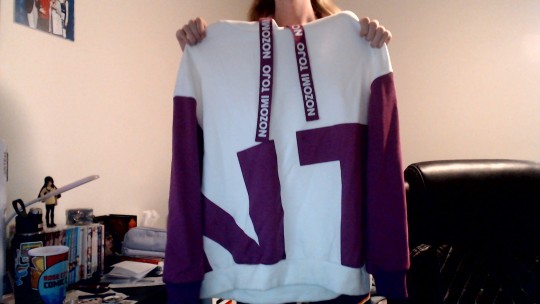

Brought the huge ace flag out over the weekend.
#love live#love live! school idol project#love live school idol project#nozomi toujou#nozomi tojo#Nozomi is asexual representaion
13K notes
·
View notes
Text
The question "what was marvel comics's first gay kiss?" is very interesting because. Well. There are at least 6 different answers, depending on how you define a gay and a kiss and a gay kiss. Do both participants have to be homosexual? Does only one? Does it just have to be two homosexual participants or can it just be two men/women kissing? Are we counting lesbian kisses as gay kisses? I'll present my cases and you'll judge.
Admittedly, some of these kisses are gag kisses, and they're played for jokes. But should they still count? If they do, maybe I'm missing a whole lot of homophobic kisses between men before the year 1999. But this is what I know of. Feel free to educate me and let me know differently if there were any earlier gay kisses I missed. I didn't include mouth-to-mouth operations, no matter how gay they were (sorry, Storm and Yukio), because I feel like they can't really be considered kisses.

Beast (Hank McCoy) & Wonder Man (Simon Williams) in Avengers #14, cover date March 1999, release date February 10th 1999.
Hank McCoy kissed Simon Williams in 1999, but is this Marvel's first gay kiss? a few points against that: a) Hank is kissing Simon, but Simon isn't kissing back. b) Neither Simon nor Hank have been confirmed to be attracted to men. Yet. c) Honetsly, this issue is gay as hell but this is just ignored by the rest of the characters, implying Hank may have pulled this shit off before. So we have one man kissing another man, but neither men are canonically gay/bi or confirmed to be attracted to each other. it's a kiss but is it gay? is it gay if they're just homies who kiss each goodnight? (note: There is an alternate universe where Wonder Man and Beast were in a romantic relationship. but not in the 616)

2. Deadpool (Wade Wilson) & Mister Snout/Unnamed Bull alien of the Last Men in Deadpool #41, cover date June (!) 2000, release date April 26th 2000.
In 2000, Deadpool kissed a man. An alien man, but this is Marvel, if I don't count aliens as men, I'd have a problem. So is this Marvel's first gay kiss with a canonically queer person? let's see. a) Again, this kiss is one-sided. Additionally, we have no idea if Bull guy is also queer. b) This is meant as a joke. It's not a sincere kiss between two men, and it has no importance in the story whatsoever. I can't speak for the writer's intention, but I doubt this was meant as queer representaion. c) Adding to the lack of importance, the bull guy doesn't have a name (but the one Wade gives him). He's a non-character. You could still argue it matters since the canonization of Kitty Pryde's bisexuality was done in a similar way and still matters. d) No lips are touching. A minor detail, but Deadpool's mask is on in this kiss, and it's unclear if Bull guy has proper lips. Is it even a kiss?

3. Bloke (Mickey Tork) & Unnamed boyfriend in San Francisco in X-Force #118, cover date September 2001, release date July 25th 2001.
While I'm not at all sure what the intention in writing behind the previous two kisses was, I know for sure this was meant to be a proud and sincere gay kiss between two men attracted to each other. Peter Milligan & Mike Allred's X-Force (and following X-Statix) run was written to be controversial, political, and satirical. However, while this kiss succeeds where the previous two fail (explicit gay representation, lips touching, willing participation of both parties), it also has its problems. a) Bloke dies in this same issue. While it is a part of the new X-Force concept, it does lend itself to the "bury your gays" trope. b) The boyfriend is unnamed and is inconsequential, like the kiss is in-story. There's no story to it. There's a nice farewell moment, and that's it. This goes nowhere. We don't see Bloke or his boyfriend again. This is an indisputable gay kiss, but beyond the status of "Marvel's first gay kiss (technically)", it doesn't mean a lot. It's something that meant a lot with the removal of the comics code authority logo on the X-Force covers, but it's a bit disappointing as the first gay kiss. So what's the first meaningful gay kiss in Marvel Comics?

4. Marlo Chandler & Moondragon (Heather Douglas) in Captain Marvel #32, cover date July 2002, release date May 2002.
Indisputably, this is Marvel's first lesbian (or sapphic) kiss. This is also the first kiss with two canonicaly queer characters. It's meaningful, as it's a moment shared between two friends who find themselves attracted to each other, and it made Marlo separate from her husband and go on to discover herself and her sexuality (and also led to a romantic relationship between the two women? I'm sorry, I don't read Captain Marvel comics, I really don't know). This is Marvel Comics's first meaningful, proper, sincere gay kiss between two queer characters.
We can stop here. We found it. But Heather and Marlo seemingly aren't important enough to be featured on any article discussing important queer marvel moments. So let's keep going until we reach the "first major Marvel Comics gay kiss".


5. Sunfire (Mariko Yashida, Earth 2109) & Spider-Woman (Mary Jane Watson, Earth 8545) in Exiles #34, cover date November 2003, release date September 24th, 2003.
If we give a unique award/title for each kiss on this list, this would be "Marvel Comics's first meaningful gay kiss between two characters in a relationship with each other". This kiss is between an alternate version of Wolverine's almost wife and Mary Jane Watson. These are almost major characters. MJ and Mariko are queer characters (in their universes), the kiss is sincere, meaningful, and properly a kiss. Since we brought up the "bury your gays" trope, it's important to note (SPOILERS TO EXILES FROM 20 YEARS AGO) that Mariko does die a few issues after this, and MJ and Mariko do not get a happy ending at all. I'd like to note that, like the previous kiss, this one was also drawn by Jim Calafiore.

6. Phyla-Vell & Moondragon (Heather Douglas) in Guardians of the Galaxy #12, cover date May 2009, release date March 25th, 2009.
While Phyla-Vell and Moondragon were shown to be in a romantic relationship and closely embraced each other prior to this issue, this is the first time they actually kiss on-panel, on the lips. PLEASE correct me if I'm wrong about this, I tried to do some fact-checking, but there isn't a lot on the internet about the two of them, and going through their joint appearances issue by issue got tiring (though I promise I will try to read more about them in the future). This isn't a landmark for anyone but Heather and Phyla, but if we're in the business of granting awards, this kiss is "Marvel's first meaningful gay kiss between two characters in a relationship with each other in the 616". So gay, mutual, canonically queer, sincere, meaningful and properly a kiss. But while Phyla-Vell has appeared in an MCU movie (as a child) and she and Heather got more than a few Pride variant covers, they're still not a major comic couple. Which brings us to the last kiss on our list.

7. Shatterstar & Rictor (Julio Richter) in X-Factor #45, cover date August 2009, release date June (!) 24th, 2009.
While lesbians and dead, unnamed gays were kissing pretty sporadically through the 00s, it took until 2009 for the fan-favorite gay mutant couple to get a kiss. This was major, and I'm not doubting that. Rictor and Shatterstar had been queer-coded for almost two decades at this point. But is this "Marvel's first major gay kiss"? Are Rictor and Shatterstar a major Marvel couple? I don't know. You decide. Personally, I'd award it the "Marvel's first meaningful gay kiss between two men" title. It still means a lot to a lot of people, and it's also Marvel's first meaningful gay kiss between two characters who were both created prior to the year 2000.
That's all, an overview of "Marvel's first gay kisses". June 24th, the day I'm posting this on, is also the 16th anniversary of X-Factor #45 and the Ricstar kiss, I hope I wasn't too harsh on them for their special day (I love the two characters, I didn't mean to take away from what their kiss was, only put it in persepctive of other queer kisses). Feel free to share your favorite gay Marvel kisses, and Happy Pride!
On a final final note, I didn't give titles to the first three kisses on this list, so here they are now: Beast & Wonder Man - Marvel's first gay kiss (no special qualifications edition). Deadpool & Mister Snout/Bull guy - Marvel's first gay kiss involving a canonically queer character. Bloke & his boyfriend - Marvel's first gay kiss between two canonically queer characters.
#yael's x men ramblings#WOOOH. i'm tired.#marvel#marvel comics#gay#lesbian#marvel's first gay kiss#hank mccoy#wonder man#simon williams#wonderbeast#deadpool#wade wilson#mickey tork#marlo chandler#moondragon#heather douglas#mariko yashida#sunfire#mary jane watson#mj watson#spider woman#phyla-vell#quasar#rictor#julio richter#shatterstar#phylaheather#ricstar#i want to tag all the comics these are from but tumblr's fucking tag limit. is a thing. (which technically i get but it's annoying)
60 notes
·
View notes
Text
So I’ve just finished this Netflix series called One Day. I saw one tiktok about it and filed it away in the old noggin to watch later. Mainly bc the FMC was a WOC and all WOC deserve to be the main characters in a love story.
I will say, I am absolutely shattered. Actually sick right now. I won’t say what happens, or if it’s good or bad (bc I can be shattered in a good way). I will say you should watch it.
Each episode takes place on the same day which is July 15 starting in 1988 and ending in 2007. It’s 14 episodes long (one of the reasons why I ended up watching it bc everything is 7 episodes long now😒).
Anyway, I could say a lot, but I’ll leave it to you. I highly recommend.

#one day#netflix series#romance#tv shows#tv recommendations#review#poc main characters#poc representaion in mainstream media#women of color getting the loving they deserve#emma and dexter#emma and dexter you will always be famous to me
5 notes
·
View notes
Text
Something I loved about Skeleton Crew was the casual representaion. You have a black proganist who has a widower dad, the disabled daughter of two lesbians (who are Asian), the child of a single girlboss mother, and Neel. Who has the only 'normal' family dynamic in the group, and happens to be a blue elephant child who also eats through his fingers. And they all just, exist. Together. With no issue. I love it.
75 notes
·
View notes
Note
I think the simplicity adds quite a bit of charm to the things you draw
I love your skrunkly style
Thank you!!! :D
Glad people like it I thought it was too simple idk lol one day i will post some more rendered drawings ☝️☝️
#also i think one of the besg representaions of “too simple” should not be a worry is the youtuber icecreamsandwhich#all his videos are animated with people who are boxes with circles as heads and sticks for limbs#the only differences that ever happen is women get hair and important people get different shirts
13 notes
·
View notes